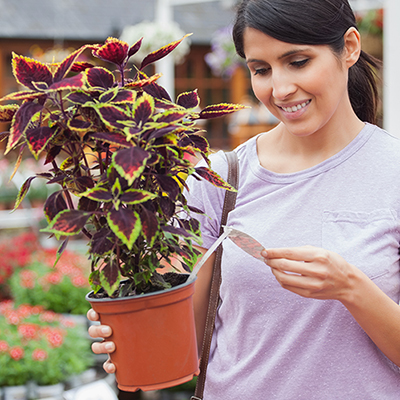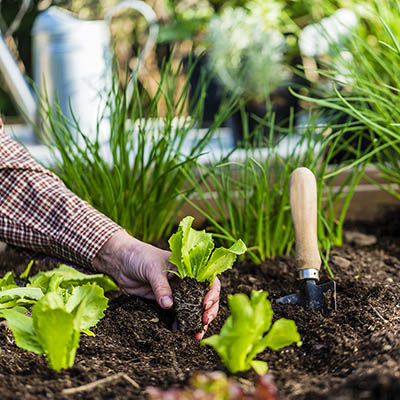Find Your USDA Plant Hardiness Zone

Last updated August 15, 2024
Grow the best outdoor plants for your garden when you start with your site’s hardiness zone. “Right plant, right place” is a fundamental principle of gardening. When you know your area's USDA hardiness zone, you can select the flowers, edibles, shrubs and trees that will not just survive, but thrive in your garden.
The USDA Plant Hardiness Zone map shows average minimum winter temperatures across the country and breaks out zones. There's a total of 13 zones with temperatures ranging from -60 degrees Fahrenheit (Zone 1) to 70 degrees Fahrenheit (Zone 13). The hardiness zone map shown is the November 2023 updated version from USDA.
At the top of the hardiness zone map, you'll find Zone 1. Traveling south, the numbers increase to zone 10 in the southernmost points of the United States. Each zone represents a 10 degrees Fahrenheit range. For example, zone 7 is the pale green belt across the middle of the country. In zone 7, the average lowest temperature in winter is 0 to 10 degrees Fahrenheit.
In this guide, you'll learn your area's planting zone and how to know what to grow in your garden.
Table of Contents
Know Your Hardiness Zone
What Is My Planting Zone?
Know Your Hardiness Zone

Knowing your hardiness zone is a key piece of information to help you plan a durable and successful garden. For example, it's important to learn what plants are perennial in your zone and will return each year. You can save money and time when you plant perennial flowers instead of annuals. Learn more about the differences between annuals and perennials.
It's easy to find plant zone info. The zone info is located on seed packets, plant tags and online descriptions. When you shop for winter hardy plants, choose your zone and the next coldest zones. For example, if you live in zone 6, choose plants that are winter hardy to zones 6, 5, 4, 3 and 2. Plants that fall in your range should perform well in your landscape.
Keep in mind that plants that can handle zone 2 winter cold may not tolerate the heat of a zone 6 summer. Your area's heat in summer is a key piece of information not found in hardiness zone maps. The best sources for information on heat tolerance are online heat zone maps, plant tags and online plant descriptions.
What Is My Planting Zone?

In the chart, locate your area of the United States. Follow the color-coded key to find your zone.
Keep in mind that hardiness zones are guidelines for good organic gardening practice. Your gardening space may have a microclimate that’s a little warmer, drier, cooler or wetter than the zone map says. The maps are based on averages, and if you’ve watched the weather for a while, you know that there are seasons of extreme weather patterns. In addition to purchasing the right plant for the right place, you can also take extra care to protect the plants in your garden. Make sure plants have well-draining soil by adding organic compost to the planting bed. Protect plants from extreme cold with a blanket of mulch.
Much of the U.S. gardens in USDA planting zones 4 through 8. The average minimum temperature range for these four zones is –30 degrees Fahrenheit to +20 degrees Fahrenheit.
Zone 1, the coldest zone, is found only in some parts of Alaska, with temperatures ranging from -60 degrees Fahrenheit to -50 degrees Fahrenheit. Native plants do best, but some non-native plants can adapt and survive if you work with them carefully.
Zone 2 includes some of the coldest parts of the U.S. like northern Minnesota and parts of Alaska. The summer growing season is short and intense, as little as 100 days in some locales. Savvy gardeners look for native plants that thrive in this challenging climate.
Zone 3. Coldest winter temperatures for this zone range from –40 degrees to –30 degrees Fahrenheit. On the map, zone 3 covers northern Montana, North Dakota, Minnesota, Wyoming’s highest mountains and much of Alaska. Season extenders like cold frames and greenhouses help gardeners lengthen their growing seasons.
Zone 4 covers northern Midwest states from Montana to Wisconsin and into New England states Maine, New Hampshire, Vermont and New York. Zone 4 also includes parts of Alaska. The challenge for zone 4 gardeners is selecting plants that can handle winter temperatures as low as –30 degrees Fahrenheit as well as soaring summer temps.
Zone 5 stretches in a band from Idaho on the west to Colorado, Nebraska, Iowa, Wisconsin, lower peninsula Michigan and pockets of Pennsylvania. Parts of Alaska are also in this zone. Average winter temperatures can be as low as –20 degrees Fahrenheit in this area. Zone 5 gardeners have growing seasons up to 170 days, with fall’s first frost in early October.
Zone 6 forms a smile from Washington state in the west, south to Oklahoma and turns north to Connecticut. It also includes parts of Alaska. This region experiences four distinct seasons with spring weather starting in March followed by warm days in June. Winter minimum temperatures dip as low as –10 degrees Fahrenheit.
Zone 7. In the east, zone 7 runs in an arc from Connecticut, down along the east Appalachian Mountains, through central Virginia, the western areas of North and South Carolina, the Tennessee Valley, northern areas of Georgia, Alabama, Mississippi, central Arkansas and Texas. In the west, it pulls in New Mexico, Nevada, Oregon, Washington and parts of Alaska. The winters are typically mild, with temperatures as low as 0 degrees Fahrenheit. Summers are hot and humid with temperatures above 100 degrees Fahrenheit. Gardeners have a long growing season and can choose from a variety of annuals and perennials, shrubs and trees for their landscapes.
Zone 8 extends from Washington state and parts of Alaska, down along California and sweeps across Texas, through the Southeastern states up to Virginia. Average minimum temperature is 10 degrees Fahrenheit. Growing seasons are greater than 200 days, giving vegetable gardeners opportunity to sow multiple successive crops of their favorites. In the desert and dry areas,
look for drought tolerant plants that can survive drought and extreme heat.
Zone 9 includes the Western coastline, parts of Alaska, parts of South Texas, the Gulf Coast and parts of Florida. Frosts are uncommon in these areas. Average minimum temperature is 20 to 30 degrees Fahrenheit. Zone 9 gardeners’ growing season is nearly all year-round. Tropical plants that are treated as annuals in the rest of the country grow like perennials in zone 9.
Zone 10. South Florida, Southern Coastal California, and Western Arizona rarely see temperatures below 30 degrees Fahrenheit. Gardening is a year-round activity in zone 10. Managing high humidity near the coast and extreme temperatures in desert areas are challenges for zone 10 gardeners.
Your USDA hardiness zone is just one factor in describing your area's climate. Knowing your area's heat zone will help you choose plants that can handle extreme heat. The American Horticultural Society created a heat zone map marking the number of days certain areas reached temperatures above 86 degrees Fahrenheit. Use heat zone information along with first and last frost date info to make the best plant selections for your garden.
Knowing your garden's grow zone helps you choose the right plants for your garden. Another valuable piece of gardening information is your area’s average date of last frost in spring and average date of first frost in fall. These dates will help you plan spring and fall vegetable gardens. Find out your region's average date of last frost in spring and first frost in fall in this frost date calendar.
Whether you need the right planters, seeds or potting soil, The Home Depot delivers online orders when and where you need them.




































